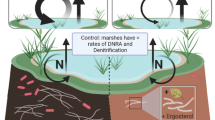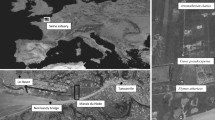Abstract
Purpose
Gully and channel erosion are known to export large quantities of soil organic matter (SOM) to stream ecosystems. However, the implications for in-stream processing of SOM ultimately depend on its susceptibility to mineralization. We studied the influence of carbon (C) and nitrogen (N) lability on fine sediment organic matter mineralization following a high flow event in a small severely eroded headwater catchment in south-eastern Queensland, Australia.
Materials and methods
High-flow event stream water was incubated for 20 days under aerobic conditions in the dark, with four treatments: control, glucose enriched, glycine enriched, and glucose + glycine enriched. Destructive sampling was carried out at 0, 2, 6, 12, and 20 days to quantify different C, N, and phosphorus (P) fractions and specific UV absorbance (a proxy for aromaticity).
Results and discussion
Net C mineralization was very slow for all treatments with rates slowing markedly towards the end of the incubation. The addition of labile N did not significantly increase net C mineralization; however, net N mineralization significantly increased with the addition of labile C in the absence of labile N. We found increasingly larger net N mineralization relative to C towards the end of the incubation, even though initial substrate stoichiometry in the control indicated that N was the limiting element.
Conclusions
Our results suggest that SOM mineralization is limited by C and not N bioavailability. One of the main implications of our study is that mineral N exported downstream in association with gully and channel eroded sediment has little influence on the in-stream processing of eroded organic C due to slow mineralization rates and fluxes in the water column. As a consequence, this mineral N would be available for generating primary productivity in downstream aquatic ecosystems.




Similar content being viewed by others
References
Abal EG, Bunn SE, Dennison WC (eds) (2005) Healthy Waterways healthy catchments: making the connection in south East Queensland, Australia. Moreton Bay Waterways and Catchments Partnership, Brisbane
APHA, AWWA, WEF (2005) Standard methods for the examination of water and wastewater, 21st edn. American Public Health Association, Washington DC
Austin AT, Yahdjian L, Stark JM, Belnap J, Porporato A, Norton U, Ravetta DA, Schaffer SM (2004) Water pulses and biogeochemical cycles in arid and semiarid ecosystems. Oecologia 141:221–235
Bernhardt ES, Likens GE (2002) Dissolved organic carbon enrichment alters nitrogen dynamics in a forest stream. Ecology 83:1689–1700
Beusen AHW, Dekkers ALM, Bouwman AF, Ludwig W, Harrison J (2005) Estimation of global river transport of sediments and associated particulate C, N, and P. Glob Biogeochem Cycles 19. https://doi.org/10.1029/2005GB002453
Bock E, Wagner M (2006) Oxidation of inorganic nitrogen compounds as an energy source. In: Dworkin M, Falkow S, Rosenberg E, Schleifer KH, Stackebrandt E (eds) The prokaryotes, vol 2. Springer, New York, pp 457–495
Bureau of Meteorology (2013) Historic annual rainfall totals for Kooralbyn station, Queensland (Archive). www.bom.gov.au. 2014
Caitcheon GG, Olley JM, Pantus F (2012) The dominant erosion processes supplying fine sediment to three major rivers in tropical Australia, the Daly (NT), Mitchell (Qld) and flinders (Qld) rivers. Geomorphology 151:188–195
Cole JJ, Prairie YT, Caraco NF, McDowell WH, Tranvik LJ, Striegl RG, Duarte CM, Kortelainen P, Downing JA, Middelburg JJ, Melack J (2007) Plumbing the global carbon cycle: integrating inland waters into the terrestrial carbon budget. Ecosystems 10:171–184
Craine JM, Morrow C, Fierer N (2007) Microbial nitrogen limitation increases decomposition. Ecology 88:2105–2113
DERM (2012) South East Queensland freshwater biogeographic provinces. State of Queensland Department of Environment and Resource Management. http://wetlandinfo.derm.qld.gov.au/wetlands/ScienceAndResearch/ConceptualModels/Riverine/FBP/South-East.html
DNRM (2013) River discharge dataset (hourly-interpolated flow), surface water database. Department of Natural Resources and Mines - Queensland Government. http://watermonitoring.derm.qld.gov.au/host.htm
Docherty KM, Young KC, Maurice PA, Bridgham SD (2006) Dissolved organic matter concentration and quality influences upon structure and function of freshwater microbial communities. Microb Ecol 52:378–388
Dungait JAJ, Hopkins DW, Gregory AS, Whitmore AP (2012) Soil organic matter turnover is governed by accessibility not recalcitrance. Glob Chang Biol 18:1781–1796
Elser JJ, Chrzanowski TH, Sterner RW, Schampel JH, Foster DK (1995) Elemental ratios and the uptake and release of nutrients by phytoplankton and bacteria in three lakes of the Canadian shield. Microb Ecol 29:145–162
Garzon-Garcia A, Olley J, Bunn S, Moody P (2014) Gully erosion reduces carbon and nitrogen storage and mineralization fluxes in a headwater catchment of southeastern Queensland, Australia. Hydrol Process 28:4669–4681
Garzon-Garcia A, Laceby JP, Olley JM, Bunn SE (2017) Differentiating the sources of fine sediment, organic matter and nitrogen in a subtropical Australian catchment. Sci Total Environ 575:1384–1394
Gomez B, Trustrum NA, Hicks DM, Rogers KM, Page MJ, Tate KR (2003) Production, storage, and output of particulate organic carbon: Waipaoa River basin, New Zealand. Water Resour Res 39:1161–1168
Gomez B, Brackley HL, Hicks DM, Neff H, Rogers KM (2004) Organic carbon in floodplain alluvium: signature of historic variations in erosion processes associated with deforestation, Waipaoa River basin, New Zealand. J Geophy Res 109. https://doi.org/10.1029/2004JF000154
Gomez R, Arce MI, Sánchez JJ, Sánchez-Montoya MM (2012) The effects of drying on sediment nitrogen content in a Mediterranean intermittent stream: a microcosms study. Hydrobiologia 679:43–59
Hadwen WL, Fellows CS, Westhorpe DP, Rees GN, Mitrovic SM, Taylor B, Baldwin DS, Silvester E, Croome R (2010) Longitudinal trends in river functioning: patterns of nutrient and carbon processing in three Australian rivers. River Res Appl 26:1129–1152
Hood E, Williams MW, McKnight DM (2005) Sources of dissolved organic matter (DOM) in a Rocky Mountain stream using chemical fractionation and stable isotopes. Biogeochemistry 74:231–255
Hughes AO, Olley JM, Croke JC, McKergow LA (2009) Sediment source changes over the last 250 years in a dry-tropical catchment, central Queensland, Australia. Geomorphology 104:262–275
Kalbitz K, Schmerwitz D, Schwesig D, Matzner E (2003) Biodegradation of soil-derived dissolved organic matter as related to its properties. Geoderma 113:273–291
Kemmit SJ, Lanyon CV, Waite IS, Wen Q, Addiscott TM, Bird NRA, O'Donnell AG, Brookes PC (2008) Mineralization of native soil organic matter is not regulated by the size, activity or composition of the soil microbial biomass - a new perspective. Soil Biol Biochem 40:61–73
Kirkby CA, Kirkegaard JA, Richardson AE, Wade LJ, Blanchard C, Batten G (2011) Stable soil organic matter: a comparison of C:N:P:S ratios in Australian and other world soils. Geoderma 163:197–208
Kogel-Knabner I (1997) 13C And 15N NMR spectroscopy as a tool in soil organic matter studies. Geoderma 80:243–270
Lal R (2003) Soil erosion and the global carbon budget. Environ Int 29:437–450
Lane CS, Lyon DR, Ziegler SE (2013) Cycling of two carbon substrates of contrasting lability by heterotrophic biofilms across a nutrient gradient of headwater streams. Aquat Sci 75:235–250
Ludwig W, Probst J (1996) Predicting the oceanic input of organic carbon by continental erosion. Glob Biogeochem Cycles 10:23–41
Manzoni S, Porporato A (2009) Soil carbon and nitrogen mineralization: theory and models across scales. Soil Biol Biochem 41:1355–1379
Manzoni S, Porporato A (2011) Common hydrologic and biogeochemical controls along the soil-stream continuum. Hydrol Process 25:1355–1360
Manzoni S, Trofymow JA, Jackson RB, Porporato A (2010) Stoichiometric controls on carbon, nitrogen, and phosphorus dynamics in decomposing litter. Ecol Monogr 80:89–106
Marín-Spiotta E, Gruley KE, Crawford J, Atkinson EE, Miesel JR, Greene S, Cardona-Correa C, Spencer RGM (2014) Paradigm shifts in soil organic matter research affect interpretations of aquatic carbon cycling: transcending disciplinary and ecosystem boundaries. Biogeochemistry 117:279–297
Maurice PA, Leff LG (2002) Hydrogeochemical controls on the organic matter and bacterial ecology of a small freshwater wetland in the New Jersey pine barrens. Water Res 36:2561–2570
McDowell WH, Zsolnay A, Aitkenhead-Peterson JA, Gregorich EG, Jones DL, Jodemann D, Kalbitz K, Marschner B, Schwesig D (2006) A comparison of methods to determine the biodegradable dissolved organic carbon from different terrestrial sources. Soil Biol Biochem 38:1933–1942
McGuire KL, Treseder KK (2010) Microbial communities and their relevance for ecosystem models: decomposition as a case study. Soil Biol Biochem 42:529–535
McKnight DM, Boyer EW, Westerhoff PK, Doran PT, Kulbe T, Andersen DT (2001) Spectrofluorometric characterization of dissolved organic matter for indication of precursor material and aromaticity. Limnol Oceanogr 46:38–48
Moorhead DL, Sinsabaugh RL (2006) A theoretical model of litter decay and microbial interaction. Ecol Monogr 76:151–174
Murthy S, Jones K, Baidoo S, Pagilla K (2006) Biodegradability of dissolved organic nitrogen: adaptation of the BOD test. Water Environment Foundation, Washington DC
Olley J, Ward D, Pietsch T, McMahon J, Laceby P, Saxton N, Rickard B, Rose C, Pantus F (2009) Rehabilitation priorities Knapp Creek. Phase 2a report. Final report. Healthy country project, Brisbane, Australia
Olley JM, Brooks A, Spencer JS, Pietsch T, Borombovits DK (2013) Subsoil erosion dominates the supply of fine sediment to rivers draining into Princess Charlotte bay, Australia. J Environ Radioact 124:121–129
Qualls RG, Haines BL (1992) Biodegradability of dissolved organic matter in forest throughfall, soil solution and stream water. Soil Sci Soc Am J 56:578–586
Schimel JP, Bennet J (2004) Nitrogen mineralization: challenges of a changing paradigm. Ecology 85:591–602
Scott DT, Baisden WT, Davies-Colley R, Gomez B, Hicks DM, Page MJ, Preston NJ, Trustrum NA, Tate KR, Woods RA (2006) Localized erosion affects national carbon budget Geophys Res Lett 33. https://doi.org/10.1029/2005GL024644
Seitzinger SP, Harrison JA (2005) Sources and delivery of carbon, nitrogen, and phosphorus to the coastal zone: an overview of global nutrient export from watersheds (NEWS) models and their application. Glob Biogeochem Cycles 19. https://doi.org/10.1029/2005GB002606
Servais P, Barillier A, Garnier J (1995) Determination of the biodegradable fraction of dissolved and particulate organic carbon in waters. Ann Limnologie Int J Limnol 31:75–80
Sinsabaugh RL, Gallo ME, Lauber C, Waldrop MP, Zak DR (2005) Extracellular enzyme activities and soil organic matter dynamics for northern hardwood forests receiving simulated nitrogen deposition. Biogeochemistry 75:201–215
Stace HCT, Hubble GD, Brewer R, Northcote KH, Sleeman JR, Mulcahy MJ, Hallsworth EG (1972) Handbook of Australian soils. Rellim Technical Publications, Glenside
Sterner RW, Elser JJ (2002) Ecological stoichiometry: the biology of elements from molecules to the biosphere. Princeton University Press, New Jersey
Strauss EA, Lamberti GA (2000) Regulation of nitrification in aquatic sediments by organic carbon. Limnol Oceanogr 45:1854–1859
Strauss EA, Lamberti GA (2002) Effect of dissolved organic carbon quality on microbial decomposition and nitrification rates in stream sediments. Freshw Biol 47:65–74
Udy JW, Fellows CS, Bartkow ME, Bunn SE, Clapcott JE, Harch BD (2006) Measures of nutrient processes as indicators of stream ecosystem health. Hydrobiologia 572:89–102
Webster JR, Meyer JL (1997) Organic matter budgets for streams: a synthesis. J N Am Benthol Soc 16:141–161
Weishaar JL, Aiken GR, Bergamaschi BA, Fram MS, Fujii R, Mopper K (2003) Evaluation of specific ultraviolet absorbance as an indicator of the chemical composition and reactivity of dissolved organic carbon. Environ Sci Technol 37:4702–4708
Acknowledgements
We express our thanks to Rob De Hayr, Sonya Mork, Joshua Hansen, Elanor Britton, Nan Lian, Emma Wilson, and the people from the Chemistry Centre at the Department of Science, Information Technology and Innovation (DSITI) for their assistance with the chemical analysis of samples and for allowing us to carry out our experiment in their facilities. We also appreciate the chance of having valuable suggestions on the planning phase of our experiment from Rob De Hayr (DSITI), Dr. Peter Pollard, and Dr. Wade Hadwen from the Australian Rivers Institute. We acknowledge Dr. Anusuya Willis for her assistance with microscopic epifluorescence techniques, and Dr. Peter Pollard and Carolyn Polson for their technical assistance to explore the use of spectrofluorometry. We specially thank Tanya Ellison for her assistance with fieldwork.
Author information
Authors and Affiliations
Corresponding author
Additional information
Responsible editor: Nikolaus Kuhn
Rights and permissions
About this article
Cite this article
Garzon-Garcia, A., Bunn, S.E., Olley, J.M. et al. Labile carbon limits in-stream mineralization in a subtropical headwater catchment affected by gully and channel erosion. J Soils Sediments 18, 648–659 (2018). https://doi.org/10.1007/s11368-017-1832-z
Received:
Accepted:
Published:
Issue Date:
DOI: https://doi.org/10.1007/s11368-017-1832-z




